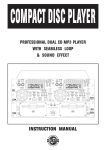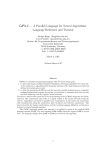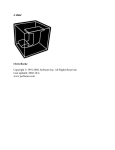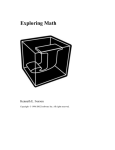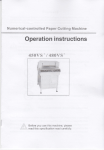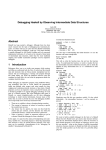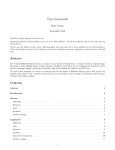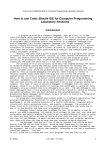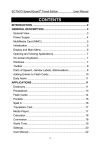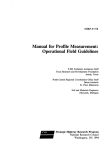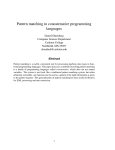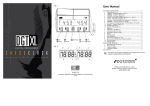Download A Brief J Reference
Transcript
A Brief J Reference This brief reference gives informal descriptions of most of the J primitives. Not every primitive is included and some idioms, examples and other resources have been added where appropriate. Since the presentation is brief and informal, it is not a replacement for the main J references: the J Introduction and Dictionary, the J User manual and the J Primer. However, since the material is informally organized by topic, this reference may be useful when considering which J features might be relevant to a given problem. Some users may also find it helps locate gaps in knowledge that can then be filled in with the main references. Chris Burke Jsoftware Inc. [email protected] www.jsoftware.com Cliff Reiter Department of Mathematics Lafayette College webbox.lafayette.edu/~reiterc Last updated August 2014 for J802. 2 A Brief J Reference Contents 1 Language Basics . . . . . . . . . . . . . . . . . . . . . . . . . . . . . . . . . . . 5 2 Nouns . . . . . . . . . . . . . . . . . . . . . . . . . . . . . . . . . . . . . . . . 6 3 Constants . . . . . . . . . . . . . . . . . . . . . . . . . . . . . . . . . . . . . . 6 4 Basic Arithmetic . . . . . . . . . . . . . . . . . . . . . . . . . . . . . . . . . . . 7 5 Boolean and Relational Verbs . . . . . . . . . . . . . . . . . . . . . . . . . . . . 8 6 Name Assignment . . . . . . . . . . . . . . . . . . . . . . . . . . . . . . . . . . 8 7 Data Information and Building . . . . . . . . . . . . . . . . . . . . . . . . . . . 9 8 Data Copying . . . . . . . . . . . . . . . . . . . . . . . . . . . . . . . . . . . . 9 9 Data Indexing and Amendment . . . . . . . . . . . . . . . . . . . . . . . . . . . 10 10 Boxed Arrays . . . . . . . . . . . . . . . . . . . . . . . . . . . . . . . . . . . . 11 11 Rank . . . . . . . . . . . . . . . . . . . . . . . . . . . . . . . . . . . . . . . . . 11 12 Explicit Definition . . . . . . . . . . . . . . . . . . . . . . . . . . . . . . . . . . 11 13 Tacit Definition . . . . . . . . . . . . . . . . . . . . . . . . . . . . . . . . . . . 12 14 Verb Application to Subsets . . . . . . . . . . . . . . . . . . . . . . . . . . . . . 13 15 Gerunds and Controlled Application of Verbs . . . . . . . . . . . . . . . . . . . 13 16 Program Flow Control . . . . . . . . . . . . . . . . . . . . . . . . . . . . . . . . 14 17 Recursion 16 . . . . . . . . . . . . . . . . . . . . . . . . . . . . . . . . . . . . . . 18 Function Composition . . . . . . . . . . . . . . . . . . . . . . . . . . . . . . . 17 19 More Verbs from Verbs . . . . . . . . . . . . . . . . . . . . . . . . . . . . . . . 19 20 Conversion: Literal, Numeric, Base, Binary . . . . . . . . . . . . . . . . . . . . . 19 21 Reading and Writing Files . . . . . . . . . . . . . . . . . . . . . . . . . . . . . . 20 22 Scripts . . . . . . . . . . . . . . . . . . . . . . . . . . . . . . . . . . . . . . . . 21 23 Sorting and Searching . . . . . . . . . . . . . . . . . . . . . . . . . . . . . . . . 22 24 Efficiency, Error Trapping, and Debugging . . . . . . . . . . . . . . . . . . . . . 22 25 Randomization and Simulation . . . . . . . . . . . . . . . . . . . . . . . . . . . 23 26 Constant and Identity Verbs 23 . . . . . . . . . . . . . . . . . . . . . . . . . . . . CONTENTS 27 Exact Computations 3 . . . . . . . . . . . . . . . . . . . . . . . . . . . . . . . . 24 28 Number Theory and Combinatorics . . . . . . . . . . . . . . . . . . . . . . . . . 24 29 Circular and Numeric Verbs . . . . . . . . . . . . . . . . . . . . . . . . . . . . . 25 30 Complex Numbers . . . . . . . . . . . . . . . . . . . . . . . . . . . . . . . . . . 25 31 Matrix Arithmetic . . . . . . . . . . . . . . . . . . . . . . . . . . . . . . . . . . 26 32 Calculus, Roots and Polynomials . . . . . . . . . . . . . . . . . . . . . . . . . . 26 33 Special Datatypes . . . . . . . . . . . . . . . . . . . . . . . . . . . . . . . . . . 27 34 Graphics . . . . . . . . . . . . . . . . . . . . . . . . . . . . . . . . . . . . . . . 28 35 Qt Session Manager Short-Cut Keys . . . . . . . . . . . . . . . . . . . . . . . . 28 36 Addons . . . . . . . . . . . . . . . . . . . . . . . . . . . . . . . . . . . . . . . . 29 37 Parts of Speech and Grammar . . . . . . . . . . . . . . . . . . . . . . . . . . . 30 38 Glossary . . . . . . . . . . . . . . . . . . . . . . . . . . . . . . . . . . . . . . . 31 39 Vocabulary . . . . . . . . . . . . . . . . . . . . . . . . . . . . . . . . . . . . . . 32 4 A Brief J Reference 5 1 Language Basics Examples: fahrenheit =: 50 (fahrenheit - 32) * 5%9 10 prices=: 3 1 4 2 orders=: 2 0 2 1 orders * prices 6 0 8 2 +/ orders * prices 16 +/ \ 1 2 3 4 5 1 3 6 10 15 2 3 * / 1 2 3 4 5 2 4 6 8 10 3 6 9 12 15 cube=: ^&3 cube i. 9 0 1 8 27 64 125 216 343 512 Names 50 fahrenheit Nouns + - * % Verbs / \ Adverbs & Conjunction ( ) Punctuation =: Assignment • Verbs act upon nouns (their arguments) to produce noun results • A verb may have two distinct (usually related) meanings depending on whether it is applied to one argument (to its right), or to two arguments (left and right). • An adverb acts on a single noun or verb to its left, typically returning a verb. For example: +/ is a verb that sums its argument. • A conjunction applies to two arguments, either nouns or verbs, typically returning a verb. In the example above, ^&3 is the verb cube. 6 A Brief J Reference 2 Nouns Nouns are classified in three independent ways: • numeric or literal • open or boxed • arrays of various ranks The atoms of any array must belong to a single class: numeric, literal, or boxed. Arrays of ranks 0, 1, and 2 are also called atom, list, and table, or, in mathematics, scalar, vector, and matrix. A single entity such as 2.3 or ’A’ is called an atom. The number of atoms in the shape of a noun is called its rank. Each position of the shape is called an axis of the array, and axes are referred to by indices 0, 1, 2, etc. Boxed nouns are produced by the verb < (box). The result of box is an atom, and boxed nouns are displayed in boxes. Box allows one to treat any array (such as the list of letters that represent a word) as a single entity, or atom. 3 Constants r b e p x x j ad ar rationals; 5r4 is 45 base representations; 2b101 is 5 base 10 exponential notation (scientific notation); 1.2e14 is 1.2 × 1014 base π exponential notation; 3p6 is 3π 6 base e exponential notation; 3x2 is 3e2 extended precision; 2^100x is the exact integer 2100 complex numbers; 3j4 is 3 + 4i angle in degrees; 1ad45 is approximately 0.707j0.707 angle in radians; 1ar1 is ^0j1 a. a: _1 _ __ _. alphabet; list of all 256 ASCII characters boxed empty negative one (−1) infinity (∞) negative infinity (−∞) indeterminate 7 4 Basic Arithmetic x + y + y x - y - y x * y * y x % y % y +: y -: y *: y x %: y %: y x ^ y ^ y x ^. y ^. y x | y | y x <. y <. y x >. y >. y <: y >: y x plus y y; identity function for real y, conjugate for complex y x minus y negate y x times y signum of y is _1, 0 or 1 depending on the sign of real y x divide y reciprocal of y double y halve y square y xth root of y square root of y x to the power y exponential base e base x logarithm of y natural logarithm (base e) residue (remainder); y mod x absolute value of y minimum of x and y; (smaller of, lesser of ) greatest integer less than or equal to y; called the floor maximum of x and y; (larger of, greater of ) least integer greater than or equal to y; called the ceiling predecessor of y; y-1 (decrement) successor of y; y+1 (increment) 8 5 A Brief J Reference Boolean and Relational Verbs Result of x < y x <: y x = y x >: y x > y x ~: y x -: y -. y x +. y x *. y x +: y x *: y x e. y e. y x E. y tests are 0 if false or 1 if true. test if x is less than y test if x is less than or equal to y test if x is equal to y test if x greater than or equal to y (larger than or equal ) test if x is greater than y (larger than) test if x is not equal to y test if x is identically same as y (match) not y; 1-y for numeric y. x or y; the greatest common divisor (gcd ) of x and y x and y; the least common multiple (lcm) of x and y x nor y (not-or ) x nand y (not-and ) test if x is an item in y (member of ) test if the raze is in each open mark beginnings of list x as a sublist in y (pattern occurrence) Boolean tests are subject to a default comparison tolerance of t=:2^_44. For example, x=y is 1 if the magnitude of the difference between x and y is less than t times the larger of the absolute values of x and y. The comparison tolerance may be modified with the fit conjunction, !., as in x=!.0 y, tests if x and y are the same to the last digit. 6 Name Assignment abc=: 1 2 3 abc=. 1 2 3 'abc'=: 1 2 3 'a b c'=: 1 2 3 'a b'=: 1 2;3 cube=: ^ & 3 (exp)=: 1 2 3 names '' erase 'a b c' (4!:5) 1 global assignment of 1 2 3 to name abc local assignment of 1 2 3 to name abc. The value is only available inside the definition where it is made. indirect assignment of 1 2 3 to name abc parallel assignment of 1 to a, 2 to b and 3 to c. parallel unboxed assignment of 1 2 to a and 3 to b function assignment result of expression exp is assigned 1 2 3 list of names defined in current locale erases the names a, b, and c (snap) returns names changed since last execution of (4!:5) 1 Several foreign conjunctions of the form 4!:n deal with names. See also the Locales lab to learn about using locales to create different locations for global names. 9 7 Data Information and Building # y $ y x $ y i. y x x x x 8 i: y i: a j. b F/ y , y ,. y ,: y , y ,. y ,: y $. y number of items in y (tally) shape of array y shape x reshape of y (cyclically using/reusing data) list of indices filling an array of shape y (integer ); negative y reverses axis symmetric arithmetic sequence; for integer y, the integers from -y to y list of numbers from -a to a in b equal steps table of values of dyad F with arguments from x and y (outer product) append x to y where axis 0 is lengthened (catenate) stitch x beside y (append items) where axis 1 is lengthened; x laminated to y giving an array with 2 items ravel (string out) elements of y ravel items of y itemize, make y into a single item by adding a new length-1 leading axis sparse matrix representation of y Data Copying x # y x #^:_1 y (G # ])y x {. y {. y {: y x }. y }. y }: y |: y (<0 1) |: y replicate or copy items in y the number of times indicated by x; the imaginary part of x is used to specify the size of expansion with fill elements expand (inverse of #) selects items of y according to 1 in Boolean x, pads with fills where 0 in x selects elements of y according to Boolean test G; thus, (2&< # ]) y gives the elements of y greater than 2. shape x take of y; negative entries cause take from end of axes; entries larger than axis length cause padding with fill elements. item in 1 {. y for non-empty arrays; in general 0{y (called head ) item in _1{.y or _1{y (called tail ) drop shape x part of y; negative entries cause drop from end of axes. 1 }. y (one drop) or behead _1 }. y (negative one drop) or curtail transpose of y trace (diagonal) of matrix y 10 9 A Brief J Reference Data Indexing and Amendment I { y x I } y item at position I in y (index or from) Arrays of I give corresponding arrays of items. Boxed arrays I give positions on corresponding axes. An empty box gives all values along that axis. y amended at positions I by data x [A=: i.3 4 0 1 2 3 4 5 6 7 8 9 10 11 0 2 { A 0 1 2 3 8 9 10 11 0 2 {"1 A 0 2 4 6 8 10 (<0 2;3) { A 3 11 1000 (<0 2;3) } A 0 1 2 1000 4 5 6 7 8 9 10 1000 11 10 Boxed Arrays < y > y x ; y ; y F &.> y F &> y a: ;: y L. y F L: n y F S: n y {:: y x {:: y 11 box y open (unbox) y one level link x and y; box x and append to y; if y is unboxed, then box y first raze y; remove one level of boxing apply F inside of each boxed element of y apply F to inside of each boxed element of y and adjoin the results. boxed empty (noun called ace) boxed list of J words in string y; (word formation) depth or deepest level of boxing in y apply F at level n and maintain boxing. May be used dyadically and left and right level specified. If boxing is thought of as creating a tree structure, then adverb L: 0 may be called leaf apply F at level n and list the result (spread ) map has the same boxing as y and gives the paths to each leaf fetch the data from y specified by the path x Rank Rank can be specified by one, two or three numbers. If the rank r contains three numbers, the first is the monadic rank, the second the left dyadic rank and last the right dyadic rank. If it contains two numbers, the first gives the left dyadic rank and the second gives the monadic and right dyadic rank. All the ranks are the same when a single number is given. F"r y x F"(lr,rr) y x F"0 _ y N"r F b. 0 12 apply F on rank r cells of the data y apply F on rank lr cells from x and rank rr cells from y table builder when F is a scalar function constant function of rank r and result N gives the monadic, left and right ranks of the verb F Explicit Definition Explicit definitions can be made with m : n where m is a number that specifies whether the result is a noun, verb, adverb or conjunction. When n is 0, successive lines of input give the defining expressions until an isolated, closing right parenthesis is reached. Noun arguments to adverbs and conjunctions may be specified by m on the left and n on the right. Verb arguments are u and v and the derived functions use x and y to denote their arguments. 4 : 0 3 : 0 2 : 0 1 : 0 0 : 0 input mode for a dyadic verb input mode for general verb. This is the monadic definition, optionally followed by an isolated colon and the dyadic definition. input mode for conjunction input mode for an adverb input mode for a noun 12 A Brief J Reference The right argument n as in m : n, may be a string, a CRLF delimited string, a matrix, or a boxed list of strings. For example: f=: 3 : '(*:y) + ^y' defines f (y) = y 2 + ey 13 : n converts to tacit form of a verb (if possible). For example: 13 : 'x , 2 * x + y' [ , 2 * + 13 Tacit Definition In a tacit definition the arguments are not named and do not appear in the definition. In many cases the tacit form of definition is much simpler and more obvious than the equivalent explicit definition. For example: plus=: + sum=: +/ max=: >./ mean=: +/ % # assigns name plus to + sum of numeric list maximum of numeric list average of numeric list Compare the last definition with an equivalent explicit definition: mean=: 3 : '(+/y) % #y' 13 14 Verb Application to Subsets F/ y G\ y F/ \ y x G\ y G\. y x G\. y x G;._3 y G;.3 y G;._2 y x F/. y F/. y 15 insert verb F between items of y, also called F-reduction; thus +/2 3 4 is 2+3+4 apply G to prefixes of y; generalized scan F scan of y apply G to sublists of length x in y (the lists are infixes); negative x gives non-overlapping sublists. For example x avg y gives length x moving averages of data in y (where avg=: +/ % #). apply G to suffixes of y (order of execution makes this fast!) apply G to lists where sublists of length x in y are excluded (the sublists are outfixes) cut; apply G to shape x tessellations of y. In general, the rows of x give the shape and offset used for the tessellation. Include shards by specifying 3 instead of _3. cut; generalized suffix cut; apply G to sublists marked by ending with the last item in y. So }:<@}:;._2 y,CRLF gives the boxed lines of CRLF delimited text y. G;.2 y includes marked positions in sublists. G;._1 y and G;.1 y use first item to mark beginnings of sublists. G;.0 y and dyads and gerunds G are also defined. function F is applied to parts of x selected by distinct items (keys) in y. For example #/.~ y gives frequency of occurrence of items of y apply F to oblique lists from y. Gerunds and Controlled Application of Verbs ^: F^:n y F^:_ y F^:(i.n)y F^:G^:_ y F`G F/. y F`:0 y [email protected] F::G iterate function (power ) iterate F n times on y; see the Dictionary for gerund n iterate F until convergence (limit) result of F iterated 0 to n-1 times on y iterate F on y until G gives false tie verbs F and G together forming a gerund evaluate each verb in gerund F taken cyclically on data y (evoke gerund ) alternative form of evoke gerund, returning all combinations of functions from F on y agenda: use G to select verb from gerund F to apply adverse: apply F, if an error occurs, apply G instead Many adverbs and conjunctions have gerund meanings that give generalizations; e.g. gerund insert cyclically inserts verbs from the gerund. Thus, the following are the same: +`% / 1 2 3 4 1 + 2 % 3 + 4 14 16 A Brief J Reference Program Flow Control Execution control is provided by words such as: if. else. while. etc. These control words: • can occur anywhere in a line of code • group the code into blocks Here, a block is zero or more sentences, which may themselves contain control words. A J block is true if the first element of the result is not zero. In particular, an empty block is true. In all cases, the result of the last expression executed that was not a test, is returned as the verb result. if. elseif. signum=: 3 : 0 if. y < 0 do. _1 elseif. y=0 do. 0 elseif. do. 1 end. ) signum &> _5 7 8 0 _1 1 1 0 Compare: * _5 7 8 0 _1 1 1 0 select. The select. control word allows execution of expressions when a value matches those in a given case or cases. Evaluation of the select. control structure then terminates for a case. statement, or continues with the next block for an fcase. statement. An empty case matches all. 15 atype=: 3 : 0 select. #$y case. 0 do. 'scalar' case. 1 do. 'vector' case. do. 'array of dimension greater than 1' end. ) atype <i.3 3 scalar atype i.3 3 3 array of dimension greater than 1 while. whilst. The control word while. executes the loop while the control condition is true. whilst. is the same as while, except the steps of the loop are executed once before the control condition is tested. sumint=: 3 : 0 k=.0 s=.0 while. k<:y do. s=.s+k k=.k+1 end. s ) sumint 10 55 for name. Sumint=: 3 : 0 s=.0 for_k. 1+i.y do. s=.s+k end. s ) Sumint 10 55 16 A Brief J Reference break. The control word break. is used to step out of a while. or whilst. or for_name. loop, and continue. returns to the top of the loop. The control word return. can be used to exit from function execution. try. catch. The following line runs expression2 if running expression1 causes an error. try. expression1 catch. expression2 end. There are also control words for labeling lines and going to those lines: label_name. and goto_name. . 17 Recursion One can use self reference of verbs that are named. For example, the factorial can be computed recursively as follows. fac=: 3 : 'if. y <: 1 do. 1 else. y * fac y - 1 end.' fac 3 6 Also: fac=: 1:`(*fac@<:)@.* fac 3 6 fac"0 i. 6 1 1 2 6 24 120 One can also create a recursive function without naming the function by using $: for selfreference. The factorial function can be defined recursively without name as follows. (1:`(*$:@<:)@.*) 3 6 (1:`(*$:@<:)@.*)"0 i.6 1 1 2 6 24 120 17 18 Function Composition Atop F@G y x F@G y F | G | y F | G / \ x y Compose F&G y x F&G y F | G | y F / \ G G | | x y Under F&.G y x F&.G y -1 G | F | G | y -1 G | F / \ G G | | x y Hook (G H) y x (G H) y G / \ y H | y G / \ x H | y 18 A Brief J Reference Fork (F G H) y G / \ F H | | y y x (F G H) y G / \ F H / \ / \ x y x y The rank of F@G and F&G is the rank of G. At is denoted @: and is the same as @ except the rank is infinite. Appose is denoted &: which is the same as & except the rank is infinite. The ranks of the hook and fork are infinite. Longer trains of verbs are interpreted by taking forks on the right. Thus F G H J is the hook F (G H J) where G H J is a fork, and F G H J K is the fork F G (H J K). Under The verb u &. v is equivalent to the composition u & v except that the verb obverse (inverse) to v is applied to the result for each cell. For example, multiplication is sum under log: 3 + &. ^. 4 12 However, the rank of the result of u &. v is the monadic rank of v, which for many verbs is zero, whereas it is often the case that you want the rank to be infinite. An alternate form of under is &.:, which is equivalent to u &. (v"_). For example: +/ &. ^. 3 4 5 3 4 5 +/ &.: ^. 3 4 5 60 Cap [: F G has the effect of passing no left argument to F as part of the fork - the left branch of the fork is capped - thus F is applied monadically. 19 19 More Verbs from Verbs N&G G&N F~y x F~ y F : G F :. G G f. F b. _1 F b. 1 20 monad derived from dyad G with N as the fixed left argument monad derived from dyad G with N as the fixed right argument (known as bond or curry) reflects y to both arguments; i.e. y F y (reflex ) pass interchanges arguments; i.e. y F x (commute) function with monad F and dyad G (monad/dyad definition) function F with obverse (restricted inverse) G function G with names appearing in its definition recursively replaced by their meaning. This fix es (makes permanent) the function meaning obverse (inverse) of F identity function for F Conversion: Literal, Numeric, Base, Binary ": y a.b ": y ajb ": y ":!. c y ". y x ". y ".@}: ;._2 y 'm'~ #: y x #: y #. y x #. y 3 !: n 8 !: n format array y as a literal array format data in y with field width a and b decimal digits format data in y with field width a and b decimal digits, for example: 15j10 ": o.i.3 4 format data showing c significant digits execute or do string y convert y to numeric using x for illegal numbers. J syntax is relaxed so appearances of - in y are treated like _ execute expressions in CRLF delimited substrings appearing in y (that ends with CRLF) and adjoin the results value of name m is evoked binary representation of y (antibase-two) representation of y in base x (antibase) value of binary rank-1 cells of y (base-two) value of base x rank-1 cells of y (base) various binary conversions; for example, 1 (3 !:4) y converts J floats to binary short floats while _1 (3!:4) y converts binary short floats to J floats. format y according to format phrase x. For example, format to width 11, decimal places 2, comma-separated, with zeros formatted to nil, and infinities to n/a: 'b<nil>d<n/a>c11.2' (8!:2) 1.23 12345 0.123,__ 0 _1234.5,:_44 0.5 0.1 1.23 12,345.00 0.12 n/a nil -1,234.50 -44.00 0.50 0.10 See also the Foreign Conjunction help. 20 21 A Brief J Reference Reading and Writing Files The following verbs are based on foreign conjunctions in the form 1!:n. These provide for file reading/writing including indexed reads and writes and creating directories, reading and setting attributes and permissions. Chopping file data in appropriate places can be accomplished with ;._2 (cut). Simple substitution (e.g., _ for -) may be accomplished with charsub from strings. See regex for more complex processing. Memory mapped files should be considered for huge data sets. 1!:0 y 1!:1 y x 1!:2 y x 1!:3 y 1!:11 y x 1!:12 y directory information matching path and pattern in y (see fdir) read file y specified by a boxed name (see fread and freads) write file y with raw, (a. or text) data x (see fwrite and fwrites) append file y with raw, a. or text data x (see fappend and fappends) indexed read. y is a pair: file name; index and length. The index may be negative. If the length is elided, the read goes to the end. indexed write. y is a pair: file name; index. For example: 'abcdefgh' 1!:2 <F=: 't1.dat' 1!:1 <F abcdefgh 1!:11 F;2 5 cdefg 'XYZ' 1!:12 F;3 1!:11 F;2 5 cXYZg Files may also be referenced by number; keyboard and screen input/output are supported, and other facilities give other useful file access including indexed i/o, permissions, erasure, locking, attributes. Convenient utilities are defined in the standard library. For example, read in a file, returning the result in a matrix: 'm' fread 'mydata.dat' See also the Files lab. 21 22 Scripts Scripts are plain text files containing J expressions. Typically the file extension is .ijs. Loading the scripts runs the J expressions. Ctrl+N 0!:0 <'filename.ijs' 0!:1 <'filename.ijs' open a new script window run the script filename.ijs; note boxing of filename run the script with display 0!:0 y 0!:1 y 0!:10 y run the J noun y as a script run the J noun y displaying the result run the J noun y and continue on errors load 'filename.ijs' similar to 0!:0 except that the script is loaded within an explicit definitions, and hence local definitions in the script do not exist upon completion. This allows a script to have definitions that are local to the script. loads a library script, for example pacman is the script system/util/pacman.ijs. Enter scripts'v' to see the list of script names. loads a script from the addons directory, for example load '~addons/stats/r/rserve.ijs' similar to load except that if the script has already been loaded, it is not loaded again. load 'scriptname' load '~addons/../filename.ijs' require 'filename' Typically, applications are built from several scripts. The Project system helps you access and manage your J script files. For example, it lets build you applications from several scripts. Scripts are maintained individually during development, and can be compiled into a single output script for distribution/runtime/installation purposes. You can customize the build to suit your application. For more information, see the wiki pages Guides/Folders and Projects and Guides/J8 Standalone. 22 23 A Brief J Reference Sorting and Searching /: y x /: y /:~ y /:/: y \: y x i. y x e. y e. y x E. y I. y x I. y ~. y ({.,#)/.~y ~: y = y (G # ])y x -. y 24 grade up; indices of items of y ordered so that the corresponding items of y would be in nondecreasing order sort x according to indices in /:y sorts items of y into nondecreasing order rank order of items in y grade down; indices of items of y ordered so that the corresponding items of y are in nonincreasing order indices of items of y in the reference list x test if x is an item in y (member of ) test if the raze is in each open mark beginnings of list x as a sublist in y (pattern occurrence) indices of 1 in boolean list y; thus I.y<4 gives indices where y is less than 4 indices of y in the intervals defined by x nub of y; that is, items of y with duplicates removed (unique) may use key to get nub and frequencies appearing in y nubsieve: Boolean vector v so v#y is ~.y self-classify y according to ~. y selects items of y according to Boolean test G; thus, (2&< # ])y gives items of y greater than 2. items of x less those in y Efficiency, Error Trapping, and Debugging 6!:2 y 7!:2 y u :: v try. e1 catch. e2 end. time (seconds) required to execute string y. Optional left argument specifies number of repetitions used to obtain average run time space (bytes) required to execute string y result of applying verb u unless that results in an error in which case v is applied (adverse) is similar except expressions in explicit definition mode are executed instead of verbs being applied The try/catch control structure may contain one or more distinct occurrences of catch. catchd. catcht. (in any order). For example: try. B0 catch. B1 end. try. B0 catcht. B1 catchd. B2 end. try. B0 catcht. B1 catch. B2 catchd. B3 end. The B0 block is executed and: 23 catch. catchd. catcht. catches errors, whatever the setting of the debug flag 13!:0 catches errors, but only if the debug flag is 0 catches a throw. expression The foreign conjunctions 13!:n provide the underlying debugging facilities, while the Debug application provides interactive debugging, see the Debug lab. The Performance Monitor provides detailed execution time and space used when running an application, see the Performance Monitor lab. 25 Randomization and Simulation ? y ?. y x ? y ? 0 9!:0 '' 9!:1 y randomize '' random index from i.y; called roll ; for example, +/\(?100#2){_1 1 is a 100 step random _1 1 walk default random index from i.y using 16807 as the random seed x random indices dealt from i.y without duplication random number in range [0,1) query random seed set random seed to y randomize random seed; randomize is defined in numeric.ijs See also ~addons/stats/base/random.ijs for various random number utilities, and ~addons/stats/base/distribution.ijs for generating various distributions. For example: 3 deal ;: 'anne henry mary susan tom' +-----+----+---+ |susan|mary|tom| +-----+----+---+ normalrand 5 NB. mean 0, sd 1 0.719033 _0.512529 0.801304 0.436659 _0.0496758 26 Constant and Identity Verbs ] y x ] y [ y x [ y + y 0: y 1: y _: y N"r result is y, the identity function on y result is y (right) result is y, the identity function on y result is x (left) result is y if y is a real number result is the scalar 0 result is 1; likewise, there are constant functions _9: to 9: result is the infinite scalar _ constant function with value N for each rank r cell 24 27 A Brief J Reference Exact Computations 2x or 2r1 2x^100 2r3 x: y x:^:_1 y 2 x: y exact integer 2 (extended precision) exact integer 2100 exact rational number 32 (extended precision) convert y to extended precision rational convert y to fixed precision numeric numerator and denominator of extended precision rationals There is special code to avoid exponentiation for extended precision arguments when using residue, for example: m&|@(2x&^) y 28 computes 2y mod m efficiently (without computing 2y ) Number Theory and Combinatorics p: y p:^:_1 y x p: y q: y x q: y x +. y x *. y gcd y x | y ! y x ! y A. y x A. y C. y x C. y { y y-th prime number (in origin 0) number of primes less than y various number theoretic functions: next prime, totient, etc. prime factors of y prime factors of y with limited factor base greatest common divisor (gcd) least common multiple (lcm) function gcd defined in ~addons/math/misc/gcd.ijs results in the gcd of the elements of y along with the coefficients whose dot product with y gives the gcd. Also useful for finding inverses modulo m. residue (remainder) y modulo x factorial of y for integer y and Γ(y + 1) in general number of combinations of x things from y things (generalized) atomic representation (position) of permutation y applies permutation with atomic representation x to y (atomic permute, anagram). For example, (i.!n) A. i.n is all permutations of order n cycle representation of numeric permutation y as a boxed list; visa versa when y is boxed permutes y according to permutation x (either in numeric or boxed cyclic representation) Cartesian product: all selections of one item from each box in y. 25 29 Circular and Numeric Verbs Many trigonometric functions and other functions associated with circles are obtained using o. with various numeric left arguments. o. y πy (pi times) 0 o. y 1 o. y 2 o. y 3 o. y 4 o. y 5 o. y 6 o. y 7 o. y 8 o. y 9 o. y 10 o. y 11 o. y 12 o. y p 1 − y 2 (circle functions) sin(y) cos(y) tan(y) p 1 + y2 sinh(y) cosh(y) tanh(y) p −(1 + y 2 ) real part(y) abs(y) which is |y imaginary part(y) arg(y) m H. n y x m H. n y 30 _1 o. y _2 o. y _3 o. y _4 o. y _5 o. y _6 o. y _7 o. y _8 o. y _9 o. y _10 o. y _11 o. y _12 o. y sin−1 (y) cos−1 (y) tan−1 (y) p y2 − 1 sinh−1 (y) cosh−1 (y) −1 tanh p (y) − −(1 + y 2 ) y conjugate(y) √ yi where i is −1 eiy hypergeometric function; sometimes denoted F (m; n, y) hypergeometric function using x terms Complex Numbers Complex numbers are denoted with a j separating the real and imaginary parts. Thus, the complex number commonly written 3.1 + 4i is denoted 3.1j4. + y | y * y j. y x j. y +. y *. y r. y x r. y complex conjugate of y magnitude of y generalized signum; complex number in y direction complex number 0jy; that is, iy (imaginary) complex number xjy; that is, x + iy (complex ) pair containing real(y) and imaginary(y) polar pair (r, θ) where y = reiθ , (length, angle) is eiy (angle to complex ) is xeiy (polar to complex ) 26 31 A Brief J Reference Matrix Arithmetic x +/ . * y x +/ . = y x F/ . G y x H . G y -/ . * y F . G y x %. y %. y |: y x |: y |. y x |. y =@i. y 128!:0 y matrix product of x and y (dot product for vectors) number of places where vector arguments match inner product; F-insert applied to pairwise G’s applied row by column; the last axis of x and first axis of y need to be compatible (same or 1) and that axis collapses in the product. inner product; H applied to cells of G applied rank _1 _ determinant of y generalized determinant; +/ . * gives the permanent. matrix divide; solution z to the linear matrix system x = y +/ . * z; least squares solution is given when appropriate matrix inverse or pseudo-inverse of matrix y transpose of y generalized transpose of y. Axes listed in x are successively moved to the end. reverse items in y rotate items in y by x positions downward along the last axis y by y identity matrix; multiply by diagonal to get a diagonal matrix QR decomposition of y The J Addons Lapack and FFTW give extensive linear algebra and fast Fourier transform utilities, respectively. 32 Calculus, Roots and Polynomials F D. F d. x F D: F t. F t: F T. p. y n n n n n n x p. y p.. y x p.. y y y y y n-th derivative of F at y n-th derivative rank zero: compare to (F D. 1)"0 y slope of secant of F at y and x+y n-th Taylor series coefficient of F about 0 n-th Taylor series coefficient of F about 0 weighted by !n n-th degree Taylor polynomial for F about 0 evaluated at y polynomial ; toggles between coefficient representation and leadingcoefficient-with-root boxed representation of polynomials. polynomial specified by x evaluated at points y. The coefficients x are in ascending powers, for example 2 1 3 p. is the polynomial 3x2 + x + 2. coefficients of derivative of polynomial y integral of polynomial y with a constant term x 27 33 Special Datatypes Sparse arrays provide a compact and efficient storage form for very large arrays where most elements are zero or some other sparse element. The verb $. converts a dense array to sparse, and $.^:_1 y ($. inverse) converts a sparse array to dense. A sparse array has a single sparse element, plus an array of other values and a matrix of their corresponding indices. The sparse attribute can be assigned to axes individually. Non-sparse axes are known as dense axes. J primitives work directly on sparse arrays, and operations give the same results when applied to dense and sparse versions of the same arrays. In other words, the following identities hold for any function f , with the exception only of those (like overtake {.) which use the sparse element as the fill. f -: f &. $. f -: f &. ($.^:_1) All primitives accept sparse or dense arrays as arguments (e.g. sparse+dense or sparse$sparse). Symbols are a mechanism for searching, sorting, and comparisons on data that is much more efficient than alternatives such as boxed strings. Structural, selection, and relational verbs work on symbols. The monad verb s: converts arrays into symbols. Several types of arguments are acceptable: • string with the leading character as the separator • literal array where each row, excluding trailing blanks, is the name of a symbol • array of boxed strings Unicode is a 2-byte (16-bit) character datatype. The verb u: creates unicode arrays. The monad applies as follows: Argument 1-byte characters 2-byte characters integers Result same as 2&u: copy of argument same as 4&u: The inverse of the monad u: is 3&u: The dyad u: takes a scalar integer left argument and applies to several kinds of arguments: 28 A Brief J Reference Left 1 2 3 4 5 Right 2-byte characters 1-byte characters 2-byte characters integers 2-byte characters 6 1-byte characters Result 1-byte characters; high order bytes are discarded 2-byte characters; high order bytes are 0 integers 2-byte characters; integers must be from 0 to 65535 1-byte characters; high order bytes must be 0 (and are discarded) 2-byte characters; pairs of 1-byte characters are converted to 2-byte characters 1&u: and 2&u: is an inverse pair, as are 3&u: and 4&u: . 34 Graphics J offers a great number of graphics facilities. Running the Graph Utilities, Plot and Viewmat labs is recommended. Plot provides a powerful high level set of standard plotting functions, while Viewmat gives a visual display of a table. The underlying functions are in the gl2.ijs script. 35 Qt Session Manager Short-Cut Keys Many J menu short-cut keys are defined, for example: Enter F1 Ctrl+F1 Ctrl+Shift+F1 Ctrl+Shift-up-arrow Ctrl+D Ctrl+E captures current line for editing on the execution input line Vocabulary context sensitive Vocabulary context sensitive NuVoc scroll up in execution log history window with execution history load selection 29 36 Addons There are several addon packages available from the J wiki, see the page JAL, such as: fftw jod lapack publish SQLite stats tabula tara fast fourier transform package. J object database linear algebra package. builds pdf reports from markup. provides J bindings to SQLite embedded engine various statistical functions scientific calculator. reads and writes files in Excel format. Install from menu Tools|Package Manager. 30 37 A Brief J Reference Parts of Speech and Grammar Most words are denoted with an ASCII symbol found on standard keyboards, or such a symbol followed by a period or colon. For example, we may think of % as denoting a J word meaning reciprocal, and %. as an inflection of that word meaning matrix inverse. Basic data objects in the language are nouns. These include scalars, such as 3.14, as well as lists (vectors) such as 2 3 5 7, matrices which are a rectangular arrangement of atoms and higher dimensional arrays of atoms. In general, arrays contain atoms that are organized along axes. These arrays may be literal, numeric or boxed. Any array may be boxed and, thereby, be declared to be a scalar. Nested boxing allows for rich data structures. The number of axes of an array gives its dimension. Thus, a scalar is 0-dimensional, a vector is 1-dimensional, a matrix is 2-dimensional and so on. The shape of an array is a list of the lengths of its axes. Often, the shape can be imagined as being split into two portions, giving an array of arrays. The leading portion of the split gives the frame (the shape of the outer array) and the other portion corresponds to the shape of the arrays, giving what are called cells. The items are the cells that occur by thinking of an n-dimensional array as a list of (n-1)-dimensional arrays. That is, items are rank _1 cells. Functions are known as verbs. For example, + denotes plus, %: denotes root, and (+/ % #) denotes average. Adverbs take one argument (often a verb) and typically result in a verb. For example, insert, denoted by / is an adverb. It takes a verb argument such as + and results in a derived verb +/ that sums items. Notice that adverbs take arguments on the left. The derived verb may itself take one noun argument (where it is a monad) or two noun arguments (where it is a dyad). It is sometimes helpful to be able to view a function as an object that can be formally manipulated. This facility is inherent in the J gerund. Gerunds are verbs playing the role of a noun. Conjunctions take two arguments and typically result in a verb. For example, . (dot) is a conjunction (be careful to distinguish this from a dot that is the last character in a name). For example, with left argument sum and right argument times, we get the matrix product +/ . * as the derived verb. The application of verbs to arguments proceeds from right to left. Thus 3*5+2 is 21 since the 5+2 is evaluated first. However, it is possible to think of the expression as being read left to right: 3 times the result of 5 plus 2. Therefore, verbs have long right scope and short left scope. Of course, one can use parentheses to order computations however desired: (3*5)+2 is 17. In contrast to verbs, adverbs and conjunctions bond to their arguments before verbs do. Also in contrast, they have long left scope and short right scope. Thus, we do not need the parentheses in (+/) . * to denote the matrix product since the left argument of the dot is the entire expression on its left, namely, +/ which gives the sum. Thus +/ . * denotes the matrix product. 31 38 Glossary Adverb Atom Axis Cell Conjunction Dimension Dyad Explicit Fork Gerund Hook Inflection Item Monad Noun Rank Tacit Trains Verb A part of speech that takes an argument on the left and typically results in a verb. For example, insert / is an adverb such that with argument plus as in +/ the result is the derived verb sum. A 0-dimensional element of an array; it may be numeric, literal or boxed. An organizational direction of an array. The shape of an array gives the lengths of the axes of the array. A subarray of an array that consists of all the entries from the array with some fixed leading set of indices. A part of speech that takes two arguments and typically results in a verb. For example, *:^:3 is a function that iterates squaring three times (^: is a conjunction). The dimension of an array is the number of axes given by the array’s shape. A verb with two arguments. Describes a definition which uses named arguments; for example, a verb defined using x and y.. A list of three verbs isolated in a train so that composition of functions occurs (see Section 18) A verb playing the role of a noun. A list of two verbs isolated in a train so that composition of functions occurs (see Section 18) The use of a period or colon suffix to change the meaning of a J word. A cell of rank _1. Thus, an array may be thought of as a list of its items. A verb with one argument. A data object that is numeric, literal or boxed. The dimension of cells upon which a verb operates; additional leading axes are handled uniformly. Function definition without explicit (named) reference to the arguments Lists of conjunctions, adverbs, verbs and nouns; for example, a train of three verbs is a fork. A function; when it uses two arguments, it is a dyad; and when it uses one argument, it is a monad. 32 A Brief J Reference 39 Vocabulary = < > _ Self-classify • Equal Box • Less Than Open • Larger Than Negative Sign, Infinity =. <. >. _. Is (local) Floor • Lesser Of Ceiling • Larger Of Indeterminate =: <: >: _: Is (global) Decrem • Less Or Equal Increm • Larger Or Equal Infinity + * % Conjugate • Plus Signum • Times Negate • Minus Reciprocal • Divide +. *. -. %. Real/imaginary • GCD (Or) Length/angle • LCM (And) Not (1-) • Less Mat Inv • Mat Divide +: *: -: %: Double • Not Or Square • Not And Halve • Match Square Root • Root ^ $ ~ | Exponential • Power Shape Of • Shape Reflex • Pass, Evoke Magnitude • Residue ^. $. ~. |. Natural Log • Logarithm Sparse Nub Reverse • Rotate ^: $: ~: |: Power Self Reference Nub Sieve • Not Equal Transpose . : , ; Det • Dot Product Explicit (monad, dyad) Ravel • Append Raze • Link .. :. ,. ;. Even Obverse Ravel Items • Stitch Cut .: :: ,: ;: Odd Adverse Itemize • Laminate Words • Sequential Machine # ! / \ Tally • Copy Factorial • Out Of Insert • Table, Insert Prefix • Infix, Train #. !. /. \. Base 2 • Base Fit Oblique • Key, Append Suffix • Outfix #: !: /: \: Antibase 2 • Antibase Foreign Grade Up • Sort Up Grade Down • Sort Down [ ] { } Same • Left Same • Right Catalogue • From Item Amend • Amend " ` @ & ? Rank • Constant Tie (gerund) Atop Bond, Compose Roll • Deal [: Cap {. Head • Take }. Behead • Drop {: Tail, {:: Map, Fetch }: Curtail ". Do • Numbers ": `: @: &: Default Format • Format Evoke Gerund At Appose @. Agenda &. &.: Under (Dual) ?. Roll • Deal (fixed seed) a. b. D. E. Alphabet Boolean, Basic Derivative • Member Of Interval a: C. D: f. Ace (Boxed Empty) Cycle Direct • Permute Secant Slope Fix A. d. e. H. Anagram Index • Anagram Derivative Raze In • Member In Hypergeometric i. j. M. p. Integers • Index Of Imaginary • Complex Memo Roots • Polynomial i: L. NB. p.. Axis Integers • Index Of Last Level Verb Comment Poly Deriv • Poly Integral I. L: o. p: Indices • Interval Index Level At Pi Times • Circle Function Primes q: S: T. _9: Prime Factors • Prime Exponents Spread Taylor Approximationu: Unicode to 9: Constant Verbs r. Angle • Polar t. Taylor Coeff. (m t. u t.) x: Extended Precision Font styles in the Vocabulary: noun, verb, adverb, conjunction. s: Symbol t: Weighted Taylor
































